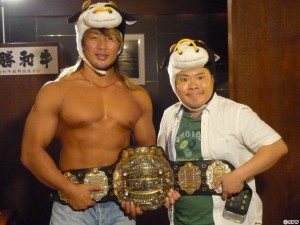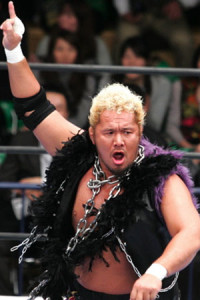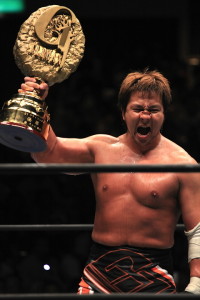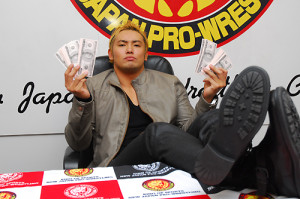The G1 (stands for Grade one) Climax tournament is New Japan’s biggest tournament of the year and arguably the biggest tournament in Japanese pro wrestling especially with the decline of All Japan Pro Wrestling. It takes place over the course of 1 week every August and was established in 1991 and has been with the exceptions of 92, 93, 97, and 98 all have been round robin format with the number of participants varying from a minimum of eight to the largest ever of twenty which first happened in 2011.
Some wrestlers have built their reputation around the tournament such as NJPW legend Masahiro Chono who is known as “MR. G1” and won the tournament a record 5 times. It’s also the traditional opportunity for up and coming wrestlers to get a big push or impress with solid matches. Losing isn’t as big a deal in Japan as it is in the US as long as you put up a good fight while doing it.
This year’s tournament not only 20 participants but is one of the most stacked with talent and big matchup’s they’ve had in years. Why they’re giving away this many quality matches up in so short a span is anyone’s guess although my personal opinion is that they want to drive home that the G1 is a huge deal to all the fans they’ve been getting back. The G1 used to be a very important thing in Japanese sports but with the decline of wrestling it obviously lost importance. With NJPW regaining momentum now is a good chance to reestablish the G1’s aura. So with all of that said let’s meet the men of G1 Climax and give you a brief bio on the first half of them!
Hiroshi Tanahashi

Tanahashi debuted in 1999 and was seen as a future superstar right from the start by NJPW. However it was in 2002 after being stabbed by an ex-girlfriend (a TV news reporter). The incident gained a great deal of attention and his return from his injuries in Feb. 03 was before a sold out crowd. His career would rapidly climb after this culminating in his first IWGP Heavyweight title win in 2006. He has held the title a total of six times and in fact is tied with Tatsumi Fujinami for most reigns and if he wins it again will only need two days to surpass Keiji Mutoh for longest combined days with the belt. His fifth title reign also holds the the record for most successful defenses at eleven.
Because he’s been so dominant since 2006 there’s a reason that you sometimes hear rumblings of him being NJPW’s John Cena. His being a pretty boy that all the ladies love him doesn’t help either. However Tanahashi almost always delivers in the ring which helps to silence the critics. He’s recently had excellent matches with Minoru Suzuki and a whole series with Kaz Okada whom he has swapped the Championship back and forth with, losing it for the last time on April 7th. There’s also his many battles with his long time rival Shinsuke Nakamura that the company has treated as their generations big matchup.
Tanahashi has only won the tournament once (in 2007) despite this being his 12th year in the G1. Of course much of that is because he’s so often been the champ and NJPW generally likes to use the G1 to build a challenger. This year though he finds himself without the gold and he’ll be looking to win the G1 and secure another title shot. As far as his chances for winning, I think NJPW will want to go in another direction after having done Tanahashi/Okada so often (and are doing it again in the tournament!) in the last year but they might find it hard to resist going to the well one more time.
Togi Makabe

go out of fashion fellas.
Makabe debuted in 1997 and started out as a Junior Heavyweight under his birth name Shinya. Makabe had limited success as a Junior and in August 2001 he announced he was leaving for overseas to gain experience, a common practice in Japan. He returned 14 months now bigger and ready to compete as a heavyweight. Before making his first G1 appearance in 2004 he changed his name to Togi Makabe but only finished in seventh out of eight in his block. Things started to turn around for Makabe though in late 2006 when Hiroyoshi Tenzan announced he was forming a new heel stable called Great Bash Heel (GBH) and Makabe was invited to join.
2007 would prove to be Makabe’s breakout year though. First in March he made it to the Finals of the New Japan Cup (NJPW’s other big singles tournament) before losing to Yuji Nagata. He would then go on to have a feud with Shinsuke Nakamura scoring several victories over him, including in a chain death match. After pinning Nagata who was the current IWGP champion in a 10 man elimination tag match Makabe received his first ever IWGP title match though he would be defeated. He would go on to form a partnership with stablemate Toru Yano and win the IWGP Tag titles in February 2008. In 2008’s G1 he would make it all the way to the finals before being defeated by Hirooki Goto.
In 2009 a now babyface Makabe would enter the G1 and win the tournament after defeating Nakamura in the finals. Hiroshi Tanahashi held the IWGP title but went down with an injury so the company schedule a G1 finals rematch to determine a new champ which Nakamura won. In 2010 though Makabe, the man who had started out as a Junior and became a Japanese Bruiser Brody had done what few if any had thought he would ever do when he beat Nakamura for the IWGP title. Since then Makabe has been kept in the mix near the top of a card but not generally in the main event, and is bought as a believable threat to any champion.
I don’t think Makabe is likely to win his block much less the Finals. He’s a guy they can bring up from the uppercard when they want to and the fans will get behind him but he just had a shot at Okada in June so I don’t see them going back to him anytime soon.
Hirooki Goto

Like Makabe, Goto also debuted (in 2003) as a Junior Heavyweight but his path to success was at least at first much easier. In early 2005 he would win his first tournament, The Young Lion Cup which was the twelfth and last version of the event ever held and was designed to showcase young talent. His 2005 would continue to be a breakout year as he turned heel and joined Jushin Liger’s Control Terrorism Unit (CTU) and teaming up with stablemate Minoru won his first championship, the IWGP Junior Heavyweight Tag Titles in May. They held on to the belts for 9 months and after losing them Goto would head off an an extended learning excursion where he would spend time in TNA, as a member of Team Japan in the 2006 World X Cup and in Mexico. After a year away, in August 2007 he returned bulked up and ready to compete as a heavyweight. Do you sense a pattern?
With a new moveset and look Goto quickly impressed and earned a IWGP title shot against champion Tanahashi but would lose a grueling match. However it was his surprise win of the G1 in 2008 that truly took him to the next level. In March 2009 Goto would prove again that when it comes to tournaments at least he’s got what it takes when he won the NJ Cup. He would win the Cup again in 2010 and 2012 (as well as the World Tag League with partner Karl Anderson in 2012) but would fail in his bids to win the IWGP title.
Goto has recently been involved in a series of brutal matches with former high school classmate Katsuyori Shibata and we’ll be getting to see another match between them since they’re in the same block this year. Hirooki hasn’t had a title shot since May of 2012 when he lost during Okada’s first reign so he’s at least a fresh opponent for Kaz and Goto does well in tournaments but NJPW doesn’t seem to really get behind him fully either and right now they have so many options I don’t see that changing for him.
Satoshi Kojima

tournament victory.
Satoshi Kojima debuted in 1991 and is one of the best known wrestlers left in NJPW (and one of the dwindling few in wrestling in general) from the 90’s glory period. It was actually against Hiroyoshi Tenzan that he made his debut and thus set the pattern of them being rivals and partners. In 1994 he won the Young Lion Cup and then headed off to Europe for a learning excursion. After he returned he would team up with Manabu Nakanishi and in 1996 they would win the IWGP Heavyweight Tag belts. However it was in 1998 when Kojima really came to to many people’s attention as he joined “The Great Muta” ‘s nWo Japan stable and formed a tag team for the first time with Tenzan.
In 2002 Kojima would follow Muta in leaving NJPW for AJPW due to Antonio Inoki’s increasingly focusing on shoot style and putting the IWGP title on shoot style wrestlers. In AJPW he would enjoy enormous success, defeating Toshiaki Kawada for the Triple Crown in 2005 and then 4 days later in an inter-promotional match his old partner Tenzan for the IWGP Heavyweight title, becoming the first to ever hold both companies titles at the same time. In July 2006 he competed in the G1 going to the finals only to lose to Tenzan (they seem to cross paths often). In 2008 TenKoji would team up once again and become the first team to ever win the G1 Climax Tag League and World’s Strongest Tag Determination League (better known in the west as the Real World Tag League) in the same year. He would have another Triple Crown reign in 2009 before leaving the company under clouded circumstances to return full-time to NJPW.
Upon his return to NJPW in 2010 he entered the G1 Climax and for the first time won the tournament by defeating Tanahashi in the finals. He followed this up by beating Makabe to win his second IWGP title. After losing the title Kojima who had turned heel formed a unit that included Taichi, TAKA, NOSAWA, and MVP. When he lost his title rematch though his own unit chose to banish him and replace him with Minoru Suzuki as their new leader. It’s worked out pretty well for them.
Since then Kojima has reformed his team with Tenzan and they are once again the IWGP Tag champs. He’s settled into a upper midcard to midcard role for the most part which is where he should be given how much wear and tear he’s got on his body. He’s capable of a main event push but there are better candidates out there and he’s one of the less likely winners.
Kazuchika Okada

Okada is the rare NJPW star that didn’t start out in their in-house dojo, receiving his training from Ultimo Dragon at his Toryumon school and debuting in 2004. Kaz would spend the next several years competing primarily on Mexico as a Junior Heavyweight but he would also appear around the world most notably in the US for Chikara. In 2007 he’d make the move to New Japan and entered their dojo briefly before making his debut. Unfortunately for Kaz (or perhaps not) he would go down with an injury and miss the better part of a year but when he returned it would be as a Heavyweight and start to get put into matches with more top stars.
At the start of 2010 NJPW decided to send Okada on an extended excursion where he would primarily be working for TNA in America. Okada would gain some experience and grow as a worker in his time in TNA but it was all about his return to New Japan, and in January 2012 at the company’s yearly dome show he made his return with a new look and persona. As “The Rainmaker” Okada had put on about 25 pounds of muscle since he’d originally left but more importantly he now had a spectacular entrance, a cocky attitude, and the full support of the company. He won his return match on the show and then to close the event he issued a challenge to IWGP champion Tanahashi immediately putting everyone on notice that he wasn’t about to work his way up the ladder. The Rainmaker was unique.
The day after the dome show Kaz announced that Gedo would now be his manager and spokesperson and he was joining CHAOS the top heel faction in New Japan. Okada shocked everyone by defeating Tanahashi in February 2012 and winning his first IWGP Heavyweight title in a excellent match. Okada became an overnight superstar and would continue his string of top-notch matches before dropping the belt back to Tanahashi in June. Kaz recovered from that loss quickly though when he entered his first ever G1 defeating Karl Anderson in the finals and breaking Masahiro Chono’s record as the youngest ever winner of the tournament. By winning the tournament he gained the right to challenge for the IWGP Heavyweight title and he announced he wanted the shot at the yearly Tokyo Dome show in January on the anniversary of his return.
The Rainmaker would come up short at the Dome in yet another epic with Tanahashi. After that Okada despite a feud with Suzukigun (where he and CHAOS where actually positioned as the faces) where he was defeated by Minoru Suzuki, he didn’t lose sight of his goal and for March’s NJ Cup announced that he had developed a new submission hold called the “Red Ink” which he intended to use to win the tournament and then regain his title. He would back up his words by defeating Hirooki Goto in the finals and earning another shot at Tanahashi. Okada faced off with and defeated Hiroshi for the IWGP title for the second time in April. Once again at the top of NJPW there isn’t any reason for him to win the G1 since the goal is to build opponents for him and he is already firmly established in the eyes of the fans. They’ll keep him strong though and he could very possibly win this block before going down in the finals.
That’s it for now but make sure to join me Thursday for Part 2!

